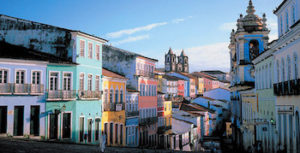
*On this date, the state of Bahia in Brazil from 1500 is affirmed. This is a former Portuguese-African slave region from the Middle Passage.
Pedro Álvares Cabral landed at what is now Porto Seguro on the southern coast of Bahia in 1500 and claimed the territory for Portugal. In its early years, Bahia was vital to the sugar economy; thus, the importation of many African slaves proceeded. More than 37% of all slaves taken from Africa were sent to Brazil, mainly to be processed in Bahia before being sent to work in plantations elsewhere in the country. In 1549, Portugal established the city of Salvador.
Bahia was a center of sugar cultivation from the 16th to the 18th centuries and contains several historical towns dating from this era. The state was also the last area of Brazil to join the independent confederation; it remained loyal to the Portuguese crown for two years after the rest of the country was granted independence. The Dutch held control of Bahia from May 1624 through April 1625. The city and surrounding area were the administrative and religious capital of Portugal's colonies in the Americas until 1763. Charles Darwin visited Bahia in 1832 on his famous Voyage of The Beagle.
As the center of the early Brazilian slave trade, Bahia is a distinctive African character in terms of culture and customs in Brazil. These include the Yoruba-derived religious system of Candomblé and the martial art of capoeira. African-derived music, such as samba, afoxé, and ахй, and foods with strong links to western Africa. Salvador is the capital of the Brazilian state of Bahia. Nearly the size of Texas, the state of Bahia holds the roots of the Brazilian nation. Bahia is the birthplace of such noted Brazilian musicians as Dorival Caymmi, Joro Gilberto, Gilberto Gil, Caetano Veloso, and his sister Maria Bethânia, Daniela Mercury, Ivete Sangalo, and Carlinhos Brown, and home to internationally famous groups like Olodum, Ara Ketu, and Ilê Aiyê. There are indigenous tribes, such as the Pataxy, who reside on the southern Atlantic coast and in the state's interior.
The state's geographical regions comprise the mata atlântica or remnants of the Atlantic coast forests; the recôncavo region radiating from the Bay (the largest in Brazil), the site of sugar and tobacco cultivation; and the planalto, which includes the fabled sertro region of Bahia's far interior. In this region, the rural Bahian town of Sro Sebastiro do Passé is one of many small hamlets where you can experience Bahian culture at a vaquejada, Brazil’s version of a rodeo. Cattle country stretches away from the hot and humid coastal region of Bahia’s sugar and coffee plantations. Brazil's second-longest river system, the Sro Francisco, runs from the Atlantic along the state's northern border down into the neighboring southern state of Minas Gerais.
Bahia is Brazil's main cacao producer and exporter. In addition to important agricultural and industrial sectors, the state also has considerable mineral and petroleum deposits. Another major industry is tourism: Bahia's long coastline, beautiful beaches, and cultural treasures make it one of Brazil's chief tourist destinations.
Other important cities in the state include Ilhéus, the birthplace of one of Brazil's prominent 20th-century writers, Jorge Amado; the old island city of Itaparica, on the island of the same name, in the Bay; Cachoeira; Vityria da Conquista; and Lençóis, in the Chapada Diamantina region. Today, Bahia possesses the most significant and distinctive African imprint in Brazil.
National Geographic Interactive,
1145 17th Street, N.W.
Washington, D.C. 20036 U.S.A
Image by David Alan Harvey